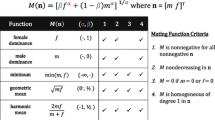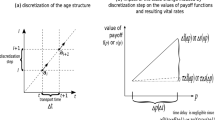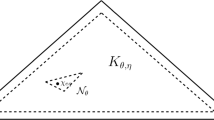Abstract
We study a generalization of the Wright–Fisher model in which some individuals adopt a behavior that is harmful to others without any direct advantage for themselves. This model is motivated by studies of spiteful behavior in nature, including several species of parasitoid hymenoptera in which sperm-depleted males continue to mate despite not being fertile. We first study a single reproductive season, then use it as a building block for a generalized Wright–Fisher model. In the large population limit, for male-skewed sex ratios, we rigorously derive the convergence of the renormalized process to a diffusion with a frequency-dependent selection and genetic drift. This allows a quantitative comparison of the indirect selective advantage with the direct one classically considered in the Wright–Fisher model. From the mathematical point of view, each season is modeled by a mix between samplings with and without replacement, and analyzed by a sort of “reverse numerical analysis”, viewing a key recurrence relation as a discretization scheme for a PDE. The diffusion approximation is then obtained by classical methods.
Similar content being viewed by others
Notes
Let us recall the unfortunate polysemy of the word “drift”. In the biological literature “genetic drift” corresponds to the noise-induced variations. When using a stochastic model, this is at odds with the “drift” of a diffusion, i.e. the first order term that models a deterministic force.
Personal communication.
Personal communication.
References
Barbour AD, Holst L, Janson S (1992) Poisson approximation. Oxford studies in probability, vol 2. The Clarendon Press/Oxford University Press/Oxford Science Publications, New York
Champagnat N, Ferriere R, Meleard S (2006) Unifying evolutionary dynamics: from individual stochastic processes to macroscopic models. Theor Popul Biol 69(3):297–321
Champagnat N, Ferrière R, Méléard S (2008) From individual stochastic processes to macroscopic models in adaptive evolution. Stoch Models 24(suppl. 1):2–44
Chalub FACC, Souza MO (2009) A non-standard evolution problem arising in population genetics. Commun Math Sci 7(2):489–502
Chalub FACC, Souza MO (2014) The frequency-dependent Wright–Fisher model: diffusive and non-diffusive approximations. J Math Biol 68(5):1089–1133
Damiens D, Boivin G (2006) Why do sperm-depleted parasitoid males continue to mate? Behav Ecol 17(1):138–143
Dionisio F (2007) Selfish and spiteful behaviour through parasites and pathogens. Evol Ecol Res 9(7):1199–1210
Durrett R (1996) Stochastic calculus: a practical introduction. Probability and stochastics series. CRC Press INC, Boca Raton
Durrett R (2008) Probability models for DNA sequence evolution, 2nd edn. Probability and its applications (New York). Springer, New York
Ethier SN, Kurtz TG (1986) Markov processes: characterization and convergence. Wiley series in probability and mathematical atatistics: probability and mathematical statistics. Wiley, New York
Etheridge A (2011) Some mathematical models from population genetics. Lecture notes in mathematics, vol 2012. Springer, Heidelberg. (Lectures from the 39th Probability Summer School held in Saint-Flour, 2009)
Ewens WJ (2004) Mathematical population genetics. I: theoretical introduction, 2nd edn. Interdisciplinary applied mathematics, vol 27. Springer, New York
Foster KR, Wenseleers T, Ratnieks FLW (2001) Spite: Hamilton’s unproven theory. Ann Zool Fenn 38(3–4):229–238
Gillespie JH (1974) Nautural selection for within-generation variance in offspring number. Genetics 76(3):601–606
Gillespie JH (1975) Natural selection for within-generation variance in offspring number II. Discrite haploid models. Genetics 81(2):403–413
Grimmett GR, Stirzaker DR (2001) Probability and random processes, 3rd edn. Oxford University Press, New York
Hamilton WD (1970) Selfish and spiteful behaviour in an evolutionary model. Nature 228(5277):1218–1220
Janson S (1994) Large deviation inequalities for sums of indicator variables. Technical Report No. 34, Department of Mathematics, Uppsala University
Joag-Dev K, Proschan F (1983) Negative association of random variables, with applications. Ann Stat 11(1):286–295
Lessard S (2005) Long-term stability from fixation probabilities in finite populations: new perspectives for ESS theory. Theor Popul Biol 68(1):19–27
McKane AJ, Waxman D (2007) Singular solutions of the diffusion equation of population genetics. J Theor Biol 247(4):849–858
Rice WR (1996) Sexually antagonistic male adaptation triggered by experimental arrest of female evolution. Nature 381(6579):232–234
Ross N (2011) Fundamentals of Stein’s method. Probab Surv 8:210–293
Radhakrishnan P, Pérez-Staples D, Weldon CW, Taylor PW (2009) Multiple mating and sperm depletion in male Queensland fruit flies: effects on female remating behaviour. Anim Behav 78(4):839–846
Shpak M (2007) Selection against demographic stochasticity in age-structured populations. Genetics 177(4):2181–2194
Steiner S, Henrich N, Ruther J (2008) Mating with sperm-depleted males does not increase female mating frequency in the parasitoid Lariophagus distinguendus. Entomol Exp Appl 126(2):131–137
Taylor JE (2009) The genealogical consequences of fecundity variance polymorphism. Genetics 182(3):813–837
Waxman D (2011) Comparison and content of the Wright–Fisher model of random genetic drift, the diffusion approximation, and an intermediate model. J Theor Biol 269:79–87
Acknowledgments
This paper stems from discussions with the biologists F.-X. Dechaume-Moncharmont and M. Galipaud, who came up with the single generation model for “indirect” fitness. We thank them for stimulating discussions on the biological aspects of the problem. On the mathematical side, our special thanks go to R. Eymard for his input on the inverse numerical analysis problem; we also thank V.-C. Tran and D. Coupier for interesting discussions. Finally we thank J.E. Taylor and an anonymous reviewer for many valuable comments on a preliminary version of this work.
Author information
Authors and Affiliations
Corresponding author
Rights and permissions
About this article
Cite this article
Goudenège, L., Zitt, PA. A Wright–Fisher model with indirect selection. J. Math. Biol. 71, 1411–1450 (2015). https://doi.org/10.1007/s00285-015-0859-2
Received:
Revised:
Published:
Issue Date:
DOI: https://doi.org/10.1007/s00285-015-0859-2




